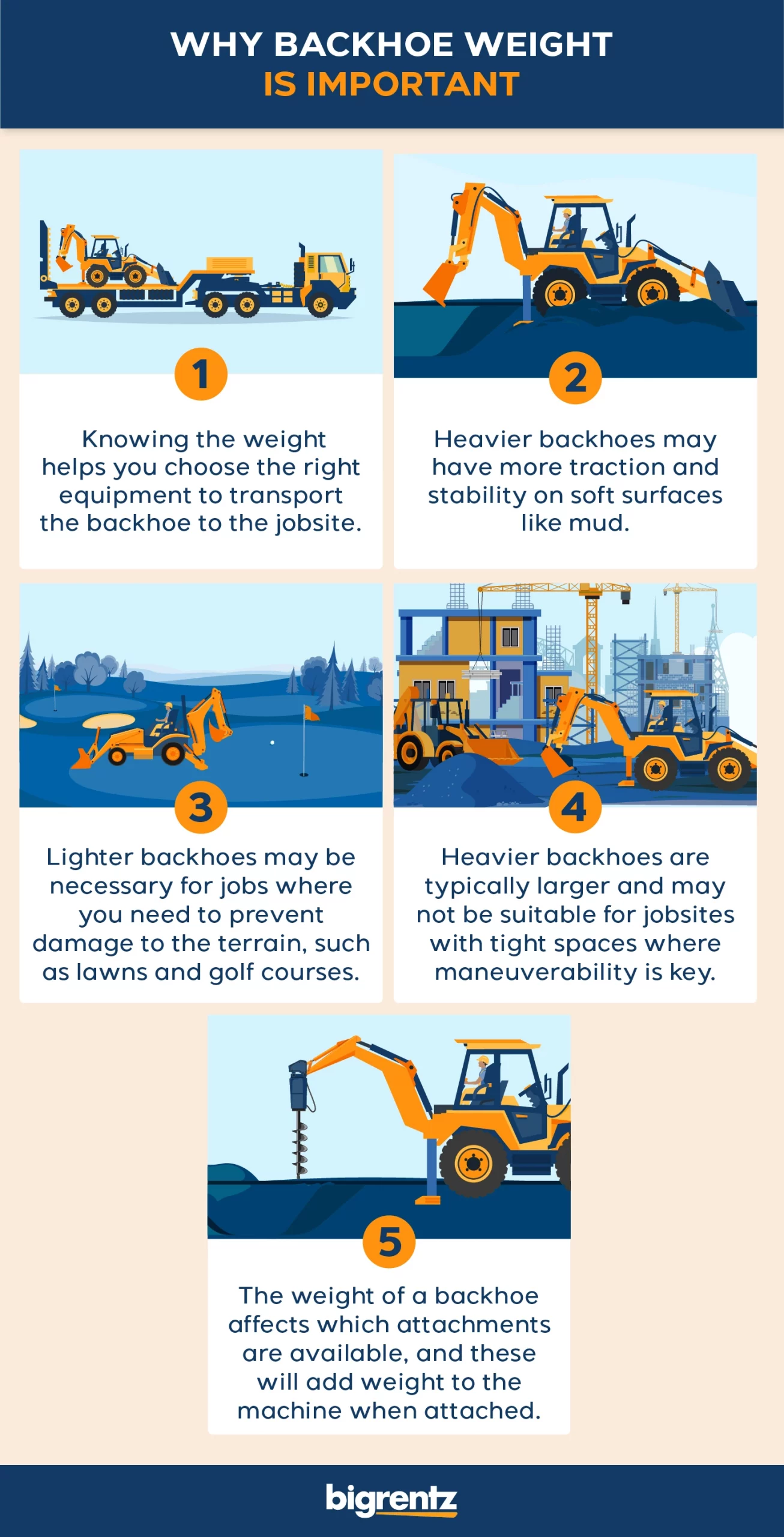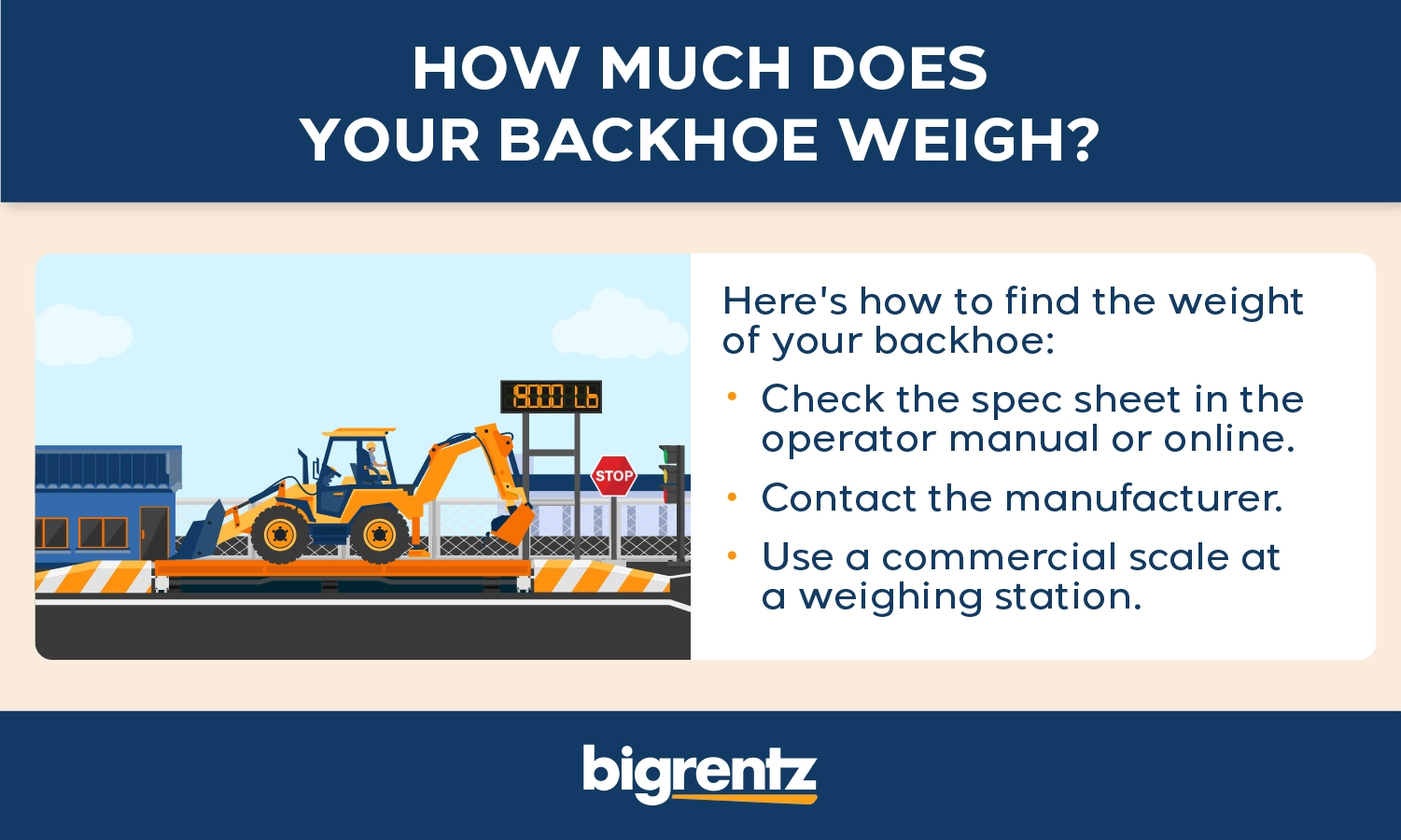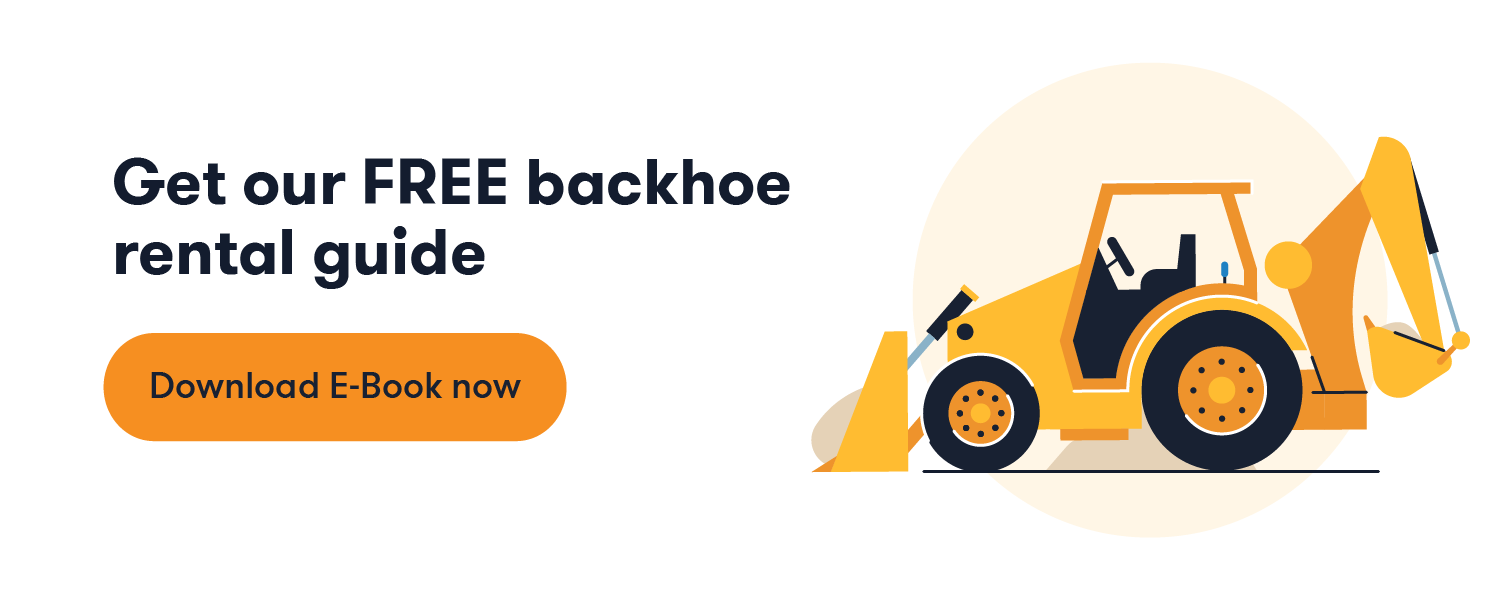A backhoe is a piece of heavy equipment equipped with a front loader, a rear bucket, and is typically four-wheel drive. Created with versatility in mind, you can use a backhoe for digging, trenching, backfilling, and loading.
You should consider weight when choosing a backhoe, because how heavy the machine is will affect both its performance and how you transport it to the jobsite.
To better manage your projects, this post lists the weights of popular backhoe models and explains in more detail why choosing the right weight is crucial.
Explore All Backhoes
Table of Contents
- How Much Does a Backhoe Loader Weigh?
- Why the Weight of a Backhoe Matters
- How to Find the Weight of Your Backhoe
- Tips for Choosing the Right Backhoe
- Rent a Backhoe from BigRentz
How Much Does a Backhoe Loader Weigh?
Backhoe weights vary by the size, make, model, and the types of attachments used. Compact machines can weigh as little as 9,000 pounds, and large heavy-duty machines can weigh up to 30,000 pounds. Typically, the heavier the operating weight, the more powerful the machine is and the deeper it can dig.
Note that attachments such as augers and large loader buckets can add weight to the backhoe, so it’s important to calculate the full weight based on what you plan to add as well as the operating weight of the machine.
The following table shows backhoe weights and dig depths for popular manufacturers and models.
| Manufacturer | Backhoe Model | Max. Operating Weight | Dig Depth | Case | Utility Plus | 18,298 lb | 14 ft 5 in | 580SV | 18,695 lb | 14 ft 5 in | 580N EP | 15,810 lb | 18 ft 6 in | 580N | 17,751 lb | 18 ft 3 in | 580 Super N | 19,067 lb | 17 ft 11 in | 580 Super N WT | 20,077 lb | 18 ft 0 in | 590 Super N | 20,532 lbb | 19 ft 6 in | CAT | 415 | 24,251 lb | 14 ft | 416 | 24,251 lb | 14 ft | 420 | 24,251 lb | 14 ft | 420 XE | 24,251 lb | 14 ft | 430 | 24,251 lb | 15 ft 1 in | 440 | 29,321 lb | 15 ft 5 in | 450 | 29,321 lb | 17 ft | 428 | 24,251 lb | 18 ft 7 in | 432 | 24,251 lb | 20 ft 2 in | 434 | 25,353 lb | 18 ft 9 in | JCB | 1CXT | 9,572 lb | 10 ft 1 in | 3CXT | 17,934 lb | 18 ft 6 in | 3CX Compact | 13,382 lb | 14 ft 2 in | 3CX-15 | 20,294 lb | 20 ft 1 in | 4CX-15 | 20,854 lb | 20 ft 2 in | 3CX-14 | 18,906 lb | 18 ft 6 in | 3CX-14 Super | 19,816 lb | 18 ft 6 in | 4CX-14 | 20,376 lb | 18 ft 1 in | John Deere | 310 G-Tier | 13,907 lb | 13 ft 8 in | 310 P-Tier | 15,221 lb | 14 ft 1 in | 320 T-Pier | 15,754 lb | 14 ft 3 in | 410 P-Tier | 17,582 lb | 15 ft 11 in | 710 P-Tier | 25,790 lb | 17 ft 3 in |
Explore All Backhoes
Why the Weight of a Backhoe Matters
The weight of your backhoe can impact all aspects of your project, from transportation to ground stability to digging capacity.

1. Transportation Options
It’s important to know the weight of a backhoe so you can safely transport it to your site. Knowing the weight of the backhoe allows you to find a trailer or truck that can haul it as well as any equipment needed to load it, such as a crane. The weight of the machine also affects how many tie-down points it needs as a load.
2. Stability and Traction
The weight of a backhoe affects its stability and traction at the jobsite. The heavier the backhoe, the more traction it has, which is useful on softer terrain like mud. Heavier backhoes generally have more stability, which may be more suitable for rough terrain, uneven surfaces, or hills. If you want to ensure that your backhoe doesn’t get stuck or tip over, you need to know its weight. Doing so will impact how you prepare the site.
3. Damage to the Terrain
Knowing a backhoe’s weight will help you understand if the machine will work well on the terrain or damage the jobsite. Certain sites, such as a residential setting or a commercial lawn or golf course, may require you to choose a lighter backhoe so you don’t damage the turf.
When considering terrain, think about the project itself as well. Some construction projects, such as multi-level projects or bridges, may have weight limits for machinery, so you must match the weight of the backhoe to any legal and safety requirements. Doing so helps to prevent damage to the surface and the machine and to protect the safety of the workers involved.
4. Digging Capacity and Size
The largest backhoes give you maximum horsepower for digging and lift capacity. If you need to dig deeper or move heavier objects, size matters as choosing a backhoe that’s too small could cause the machine to be overloaded. If you overload the machine, you may need additional tools or equipment, experience mechanical failures, or not finish the job satisfactorily. Because they are typically larger, heavier backhoes may not be suitable for sites with tight spaces and that require good maneuverability for narrow navigation.
5. Attachments Available
Attachments are one of the biggest benefits of a backhoe, offering you the option to equip it with multiple tools for specific work. However, since the attachments you choose will add weight, you have to check the spec sheet for each attachment and include that in the total weight assessment. On the flipside, the attachments you’re able to use will depend on the weight of the backhoe. Larger attachments may require a heavier machine to operate properly.
From landscaping to snow removal, backhoe attachments can help you accomplish a large number of tasks. Depending on your specific job requirements, you may use the following attachments:
- Augers
- Buckets
- Grapples
- Hammers
- Rakes
- Rippers
How to Find the Weight of Your Backhoe
If you’re not sure how much your backhoe ways, there are multiple ways you can find out.
- Check the spec sheet. In addition to detailing the parts of your backhoe, the spec sheet will indicate the weight of your backhoe. You should be able to find the spec sheet in the operator manual. If not, you may be able to find it on the manufacturer’s website.
- Contact the manufacturer. If you have an older backhoe and the spec sheet is not online, you can contact the manufacturer.
- Use a commercial scale. If your backhoe is road legal, you can drive it to a weighing station such as CAT Scale and get an accurate reading there.
When calculating the final operating weight of your backhoe, remember to include the weight of attachments plus any fluids (such as fuel).

Tips for Choosing the Right Backhoe
The suggestions below can help you select the right backhoe for your project requirements.
1. Assess the Project Requirements and Jobsite
Understanding the type of work that needs to be done, such as how deep you need to dig or what objects will be moved, is a crucial first step. This can help you narrow down your choices based on the backhoe size, weight, type, and specifications you need.
Choose a backhoe that has enough power for your applications. The terrain is also an important element for you to consider. If it’s rough, you have to make sure the backhoe can handle it and remain stable. If the surface needs to be preserved, you have to make sure the weight of the backhoe won’t damage it. If you think a backhoe won’t meet your needs because the job requires a more heavy-duty machine, you may want to choose an excavator instead of a backhoe.
2. Consider which Attachments You Need
Figure out which backhoe attachments you need and then find out their weight. Once you know the specific attachments you need, make sure you choose a backhoe that’s the right size—heavy enough and powerful enough—to handle them.
3. Determine your Budget
When choosing the heavy machinery you need to use for a construction project, consider your budget. Look at both your project budget and how long you’ll need the equipment to see whether it makes more sense to buy or rent equipment.
::backdrop{background:rgba(0,0,0,.65)}.cta–dialog[open]{border-width:0;display:flex;flex-direction:column;align-items:center;width:90%;max-width:37.5rem;padding:1.5rem}.cta–dialog[open] .dialog–close{position:absolute;top:1.25rem;right:1.5rem;font-size:30px;line-height:1}.cta–dialog[open] .dialog–header{font-size:1.5rem;font-weight:500;line-height:1.3;text-align:center;margin:1.5rem auto .5rem;padding:1.5rem 0 0}@media (min-width: 768px){.cta–dialog[open] .dialog–header{font-size:2rem;margin:0 0 .5rem;padding:0;text-align:left;width:80%}}.cta–dialog[open] .wrapper–form-illo{display:flex;flex-direction:column;align-items:center;width:100%}@media (min-width: 768px){.cta–dialog[open] .wrapper–form-illo{flex-direction:row;justify-content:center;column-gap:2rem}}.cta–dialog[open] svg{margin-top:.5rem;width:52%;max-width:11.5rem}@media (min-width: 768px){.cta–dialog[open] svg{margin-top:0;max-width:15rem}}@media (min-width: 768px){.cta–dialog[open]{align-items:flex-start}}

×
Download our FREE backhoe rental guide e-book today!
Rent a Backhoe from BigRentz
If you are looking to rent a backhoe, BigRentz provides expert advice to help you select a machine with the ideal weight and proper configurations for your project. We can also deliver it to your work site so you don’t need to worry about transportation.
Explore All Backhoes